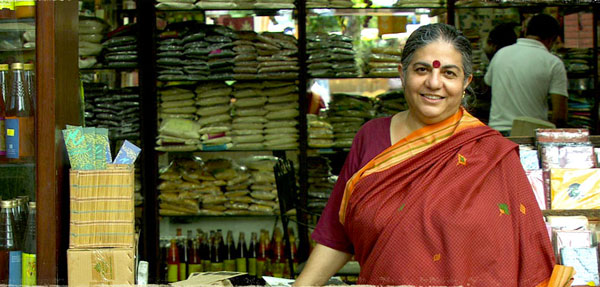In a musical context, the word dissonance is defined as 'a combination of tones contextually considered to suggest unrelieved tension requiring resolution.' In other words, the creative resolution of dissonance is harmony.
Dissonance of the cognitive variety abounded at last week's G20 meeting in Seoul where world leaders once again declared they would "spare no effort" in addressing climate change. Yet when it came to acting on their promise to phase out fossil fuel subsidies, a measure which would cut nearly 6% of energy related CO2 while bolstering the growing clean energy sector, they were clearly not singing from the same hymn sheet.
If the world's most powerful leaders agree something needs to be done on climate, and viable win-win solutions are ripe for the picking, and still they cannot deliver, it begs the question: what will it take? What more needs to shift before world leaders can overcome the obstacle of entrenched climate dissonance?
A clue maybe be found in the film version of Prince Charles' book HARMONY: A New Way of Looking at Our World, which premiered at the Kennedy Center on Monday (with a personal appearance by Hillary Clinton) and hits the national airwaves Friday night on NBC. HARMONY promotes a call-to-action that is both spiritual and political -- a search for a sustainable way of life and a harmonic partnership between humankind and the natural world.
Coming from someone else that might sound a little hippy dippy, but this is the heir to the British Crown, the future Head of State of one of the world's largest economies. And it's unusual, if not unprecedented, for a major member of the royal family to take such a strong and vocal stance:
The Earth's alarm bells are ringing loudly. We face a future where there's a real prospect that if we fail the earth we fail humanity. So we have to confront the challenges we face. This is a call to action.
The film shows nature at its most inspirational, and portrays the devastating human consequences of unsustainable development. But its real power lies in the depiction of courageous leaders championing solutions which were controversial and hard-fought in foresight, but which now seem forehead-slappingly obvious in hindsight. Like the now successful farmer in Louisiana who talks about making the transition to organic back when it was considered commercially unrealistic and economically suicidal.

And like two amazing women from India -- Vandana Shiva the de facto leader of the sustainable agriculture movement, and Reema Nanavaty who leads SEWA a trade union of 1.5 million poor self-employed women workers -- who both show that environmental protection, poverty alleviation and improved working conditions go hand-in-hand.
Great Bear Rainforest.. a way forward
A key section of the film chronicles the "War in the Woods" -- a 10-year battle over the protection of Canada's Great Bear Rainforest. We hear the story from all sides -- from people who started out on opposite sides of police lines, and ended up on opposite sides of the negotiating table.
The story is told by environmentalists, logging industry representatives and First Nation leaders, each with a deeply held conviction at odds with those of the others. And we hear how over time they learned to listen to each other, ultimately forging an historic agreement which sets aside an area the size of Ireland, bans clear-cutting, and puts control of sustainable logging into the hands of the region' indigenous people.
Those involved see this approach as the way of the future. Todd Paglia of Forest Ethics explains:
What is happening in the Great Bear Rainforest is unique. We went from just that fight between environmental groups and logging companies to something much bigger and much better and tried to work out a solution going forward that can be a model for the rest of the world, and we've done that.
Activist Valerie Langer, founder of Forest Ethics, adds:
We need to step out of our comfort bounds, work with people we never thought we would work with. It takes, I think, a tremendous amount of respect. I want it [the respect] back if I'm going to participate in the process, but I have to give it.
The Prince of Wales concludes:
The landmark agreement in the Great Bear Rainforest was a turning point and it has now inspired the framework for a new and even larger settlement encompassing 170 million acres of Canada's boreal forest. If it succeeds, it will be the largest forest conservation project in world history.
Striking a harmonious chord
While the film might at first glance seem to be too light to have any bearing on the weighty considerations of world leaders negotiating a climate treaty, it does in fact provide some hints for retuning the dissonant (some would say cacophonous) conversations occurring at the highest level of government in the run-up to the Cancun climate conference -- the unrelieved tension between the US and China, Kyoto and non-Kyoto parties, the richest and poorest countries, and so on.
Suggestions by the US and others that a climate deal could be more easily reached outside the UN process -- the only forum where vulnerable countries have as great a voice as the economic powerhouses -- should be laid to rest following the G20 performance in Seoul.
HARMONY, in particular the story of Great Bear, tells us that having a balanced representation at the negotiating table matters. It tells us that listening is as important as speaking and that true leaders show courage and integrity by accepting the possibility that others have equally valid concerns and interests.
The recent Cartagena Dialogue hosted in Costa Rica is modelling just such a process and right now many around the world are pinning their hopes on this effort to strike a harmonious chord, ultimately paving the way to a FAB (Fair, Ambitious and Binding) international agreement on climate change.
A New Way of Looking at Our Movement
In conjunction with the release of HARMONY, TckTckTck developed an innovative digital initiative to help visualize the work of organizations like Forest Ethics, countries like Costa Rica, and numerous other NGOs and individuals all of whom are working on crucial pieces of the sustainability puzzle. The initiative is called mosaic:EARTH and the beta just launched this week in tandem with the premiere of the film.
mosaic:EARTH is an embeddable widget (you can read more about the technology here) that displays the Earth as seen from space, but this time the image is made up of thousands of photos and videos uploaded to reflect the huge diversity of global civil society. The widget enables individuals to see a list of current and featured campaigns by organizations participating in the TckTckTck campaign including Oxfam, WWF (in conjunction with Leonardo DiCaprio), 10:10 Global, The Sierra Club, and many more.
With our mosaic:EARTH initiative we hope to provide a digital bridge between the inspiring messaging of the film with the on-the-ground efforts of a growing civil society movement working diligently to restore a sustainable and, yes, harmonious way of life for all Earth' inhabitants:
